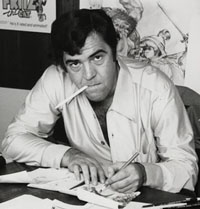
Ralph Bakshi
I sometimes worry that I am one of the last men standing who was able to meet and talk with some of the legendary animators so I feel a responsibility to share as much as I can of what they told me.
Of course, there are many animators I never got a chance to meet so I am grateful to others who did for sharing their stories and impressions.
Animator Jim Tyer (1904 -1976) had a distinct style. He got his first animation job in 1926 on the Aseop’s Fables Shorts from the Fables Studio, that became Van Beuren. While there he directed four cartoons. In 1935 he left and spent a brief time as a special effects animator at Disney, a gagman at Harman-Ising at MGM, and did animation for Jam Handy in Detroit, before joining the Paramount Studio and animating on the Popeye shorts.
In 1946, he then went to Terrytoons where he really let loose and pulled out all the stops since there really wasn’t much quality control at the time. He worked for all the Terrytoon directors of the period, Connie Rasinski, Mannie Davis and Ed Donnelly, and on all the series that the studio produced.
Tyer later worked at Joe Oriolo’s studio on Felix the Cat and The Mighty Hercules (1959-1962). For the Hal Seeger studio, he worked on Out of the Inkwell (1962-1963), Milton the Monster (1964) and Batfink (1966). At Paramount, he animated on the Snuffy Smith (1963) series. His last animation was on Fritz the Cat (1972), where he worked on the section which takes place in Harlem.As a devout Catholic often stopping at church in the morning before going to work, he had difficulty with the subject matter on that feature film and got fed up, slammed his drawings down the desk and just walked out while loudly swearing. He died four years later.
Tyer did have a ribald sense of humor and supposedly could “cuss like a soldier” but Fritz was just too much for the shy, well loved man who couldn’t bring himself to hate anyone.
Producer-director Ralph Bakshi loved and respected him. He recalled, “To my mind, Jim taught me about the possibilities of a different kind of animation than the kind being taught by Disney or even Warner Brothers. The kind of motion that is closer to John Coltrane and Miles Davis than to anything else.”
In 1994, Bakshi wrote the following about his first encounter with Tyer.
Ralph Bakshi: As a young inker at Terrytoons in 1957, I first ran across Jim’s work. In those days, there were no videos, 16mm prints or TV animation. The history and craft of animation was a mystery, except for one book about you know who. I was stunned by Jim’s drawings.
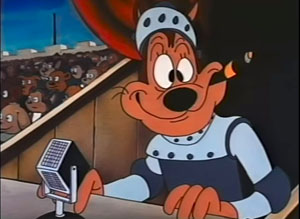 They were the funniest I had ever seen. They squashed and stretched on every frame; they changed shape everywhere; volumes were solid then loose and then long then smaller by sixty percent of the drawing before and after it.
They were the funniest I had ever seen. They squashed and stretched on every frame; they changed shape everywhere; volumes were solid then loose and then long then smaller by sixty percent of the drawing before and after it.
They fluttered and spit; they twirled and stopped and spent four feet on themselves on singles, going nowhere but changing shape subtly. The closest cartoonist to Jim that I can think of is George Herriman. Jim’s animation had the same feel as the Krazy Kat strip, pure cartooning that’s had to explain.
From that moment on, I asked the head of the Ink and Paint Department to give me only Jim Tyer’s scenes to ink. She laughed her head off. No one wanted Jim’s scenes because they were hard to ink. Every drawing was a challenge.
I became Jim’s inker and the resident idiot. The other animators at Terrytoons were all over the inking department talking about thick and thin lines, moving holds, strong poses, all the same stuff you hear now, same exact stuff.
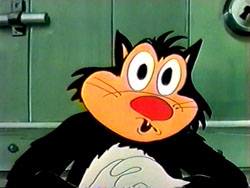 Jim never came by, not once, so I went to see him. I found him: Two hundred and eighty pounds of him sitting in his boxer shorts, long black socks with garters, skinny legs, chewing on a cigar stub, his bald head shining. He was laughing, animating a Mighty Mouse scene.
Jim never came by, not once, so I went to see him. I found him: Two hundred and eighty pounds of him sitting in his boxer shorts, long black socks with garters, skinny legs, chewing on a cigar stub, his bald head shining. He was laughing, animating a Mighty Mouse scene.
His top pegs were piled with about 25 to 30 sheets. He was flipping like mad.
“Mr. Tyer,” I said, “I’d like to ask you a question about your scene.”
“Not now, kid,” he said. “Sit here.”
He turned over an empty wastebasket so I sat down and watched. Jim was drawing a nose on every sheet of paper, just a nose. Then he’d go back and put in two eyes, going through all the sheets, never stopping, constantly flipping as the scene came alive. Crazy funny is how I saw it then.
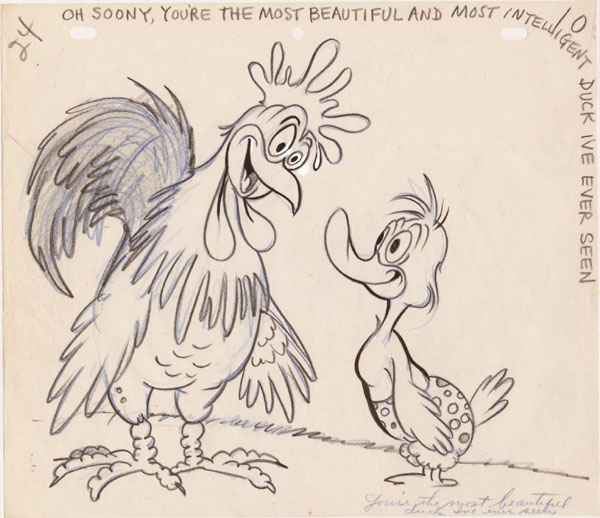
A jazz improvisation is how I saw it later. It was a brilliant way to free the animator to be himself, to allow his giddy feelings quickly into the music of the scene before it was lost on rules.
Jim was a brilliant draftsman who fought against it, forcing his scenes back to pure cartooning. Every drawing was original. Every drawing hooked up to the next but not the same arcs and overlapping action as everyone else was doing.
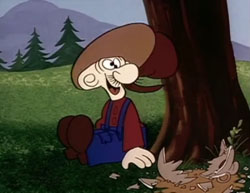
Jim Tyer’s Snuffy Smith
I showed Jim’s stuff to my young Mighty Mouse crew thirty year later. They cheered, applauded and printed out Jim’s extremes on the video printer. Tyer hung everywhere in my studio. I glowed. Jim was with us.
Jim was considered bad because he didn’t stay on model. I argued with all the directors on this point. “But you know who the character is, right? And it’s funny, right?” I would say.
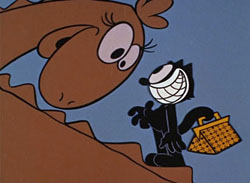
Jim Tyer’s Felix The Cat
“Wrong!” I said. “It doesn’t look like the rest of the picture because it’s funny.”
Then there was a real long silence. I said that I bet that the audience can’t tell the difference. It probably looks like the same character to them.
Jim can’t draw was the answer. “Baloney!” I shouted. “Jim’s the only guy here who’s cartooning. You’re all copying Bill Tytla and poorly at that. Why don’t you fire Jim if he’s so bad?”
They said they had tried but since he does 60 feet a week of animation, Paul Terry likes the fact that he produces the most footage in the studio. “Ha!” I laughed. Against the entire folklore animation, Jim Tyer stood alone in speed, quality, footage and originality. “Ha!”



 Jim Korkis is an internationally respected animation historian who in recent years has devoted his attention to the many worlds of Disney. He was a columnist for a variety of animation magazines. With his former writing partner, John Cawley, he authored several animation related books including The Encyclopedia of Cartoon Superstars, How to Create Animation, Cartoon Confidential and Get Animated’s Animation Art Buyer’s Guide. He taught animation classes at the Disney Institute in Florida as well as instructing classes on acting and animation history for Disney Feature Animation: Florida.
Jim Korkis is an internationally respected animation historian who in recent years has devoted his attention to the many worlds of Disney. He was a columnist for a variety of animation magazines. With his former writing partner, John Cawley, he authored several animation related books including The Encyclopedia of Cartoon Superstars, How to Create Animation, Cartoon Confidential and Get Animated’s Animation Art Buyer’s Guide. He taught animation classes at the Disney Institute in Florida as well as instructing classes on acting and animation history for Disney Feature Animation: Florida.




















































“…a gagman at Harman-Ising at MGM…”
Did Tyer also work on the sadly brief Milt Gross period at MGM? I seem to recall some Tyer-esque animation in at least one of them.
I’m pretty sure that was the work of Bill Littlejohn, but then again, judging how he had been with MGM (Albeit under The Harman-Ising Studio) it’s not entirely out of the question.
“Animator Jim Tyer (1904 -1976) had a distinct style.” – You have a flair for understatement, Jim!
Great post, BTW.
One of the first cartoons I was able to study frame-by-frame, on an abridged Super 8 reel, was Little Roquefort in “Pastry Panic”. I did not yet know the name Jim Tyer, but seeing how those wildly distorted individual drawings combined into fluid and harmonious action was as eye-opening for me as it was for the young Ralph Bakshi years earlier.
Bakshi’s comparison of Tyer’s technique to jazz artists like Miles Davis and John Coltrane has never rung true for me. I seriously doubt that Tyer had any fondness or affinity for that style of music; few people of his generation did. Rather, it seems to me that his brief stint at Disney must have had a more profound impact on his style than is generally acknowledged. In essence, Tyer brought the principles of effects animation to bear on character animation. The characters he animated for Famous and Terrytoons flow like liquid, bluster like wind, flicker like flames and sizzle like electricity. His earlier animation for Van Beuren, good as it was, was nothing like that.
In the Felix the Cat cartoon “Penelope the Elephant”, which first aired before Bakshi had turned 21, Felix and Rock Bottom vie to restore the titular pachyderm to its rightful owner, a maharajah who is offering a reward of “50 million Bakshees”. Rock double-crosses Felix and is able to collect the reward, which turns out to be equivalent to only ten cents, American. In other words, a “Bakshee” is practically worthless. I like to think that the joke is a tribute to, rather than a dig at, Tyer’s young protégé, and that Ralph laughed at it harder than anybody.
Agreed..Bahshees..whatg COULD BE but a Bakshi reference.
Tyer did these Felixes
the above mentiond “Penelope the Elephant”
“Dinah, the Dinosaur”[illustrated above], aka “Operation: Felix”, a/k/a “Do it Yourself Monster Book”
“Felix the Cat Suit”
“The Golden Whale Babysitter”
“Felix’s Prize garden”
The Leprechaun and ALL of its sequels, as far as I know, “Leprechaun Gold”
“Three Wishes on a King”, “Gold Finding Harp aka Barney”, “King of the Leprechauns”, and
“Leprechaun Gold from Rainbows”
“Fountain of Youth”
and, I think, most o fhte Master Cylinder ones.
If people like Bill Tytla, Art Babbitt or the Nine Old Men were the Old Masters, Tyer was more like Picasso, who learned how to draw the “proper” way early and decided to ignore the rules and draw how he wanted, regardless of whether it looked “right” or not. He got away with it at Terrytoons because he worked fast and his scenes were funny, and to Terry that was all that mattered.
This is a fascinating piece. It makes me now wonder just what Jim Tyer might have done for MGM–perhaps some of the chaos in the cartoon I talk volumes about, “CIRCUS DAZE”? I could imagine Tyer working on that muddle of scenes beginning with Jojo the dog-face boy, turning his head around so he can vigorously chew off the overwhelming amount of fleas on his back and hind quarters, or the next scene with the elephant literally being driven buggy as the swarm attacks it from all sides, rolling on its back while scratching at its belly with all four “paws”, followed by those scenes as the other caged animals begin gnawing at themselves or the bars of their cages…or maybe Tyer had done scenes in the CAPTAIN AND THE KIDS cartoon, “Blue Monday”, where Cap spends much of the cartoon grotesquely sputtering about everything going wrong around him. I think of how the hair on his face even struggles when he is being pulled upwards by the vacuum cleaner suction run amuck to the ceiling vent. Those kinds of wild takes seemed closest to what Tyer would later do for so many Terrytoons. Off model was the name of the game, and Jim Tyer proved that it would fit in so well once the cartoon is completed and shown. I could only imagine what pencil tests must have looked like.
Dem shrink-takes! Totally Dingbat-**** crazy!
As a kid (50s-60s) the difference between Tyer and everyone else stuck out to me like a big wobbly sore thumb. I didn’t know the whos and whys, even if I did understand the process (courtesy of Walter Lantz “tutorials”). But the immediate impact couldn’t be missed; these segments were far funnier and crazier than the rest of any given cartoon.
Little details like his – especially when done for no apparent reason – make an otherwise ordinary chase cartoon soar. Can’t remember the exact title, but a standout was a cat (from a Roquefort cartoon) running away from something. His feet were moving FROM HIS ANKLES(!) rather than his legs moving from his hips. Had NOTHING to do with the story, but made it impossible for me to take my eyes off the screen. What’s gonna happen next?
For someone whose bosses complained about his work, JT sure hung around his respective studios for a long time.
The jazz-improv description is interesting. I suppose some of his animation choices were spur-of-the-moment moves, yet everything is necessarily deliberate. Indeed, there are any number of scenes where characters are drawn perfectly on-model.
Tyer and Scribner. Two peas in a pod.
Thanks Jim!
Public-domain comics publisher, Gwandanaland Comics, is offering a collection of Tyer’s comic book work, “The Jim Tyer Comic Album (Gwandanaland Comics #3014)”, which looks to consist of his early/mid-Forties’ “funny animal” stories (I don’t have it yet, so I can’t fully describe the contents). It’s available from their website or on Amazon.
How could anyone who weighed 280 pounds have skinny legs? Though perhaps it explains the anatomical looseness of his animation. I have to say that I prefer Mr. Tyer’s mid-’40s Popeye to the tidier but bland character Tom Johnson made of him.
Jim:
Rosalie Waldman had quite a funny story about Jim Tyer when he was at Famous, working on POPEYE cartoons. It’s in the old DVD of POPEYE ORIGINAL CLASSICS set of cartoons that Thunderbean put out years ago. (I’m still waiting for Steve to send me a batch of the new updated Blu-Ray editions of this. If you don’t have the old version – I know the interview clip is on there and it’s a hilarious story – let me know and I’ll send you a copy. (I have several of the old DVD sets).
I wish to join my old pal “Top Cat James” in shouting-out Jim Tyer’s comic book work for the Terrytoons titles published by St. John during the period where “The Forties” transitioned into “The Fifties”.
While there were usually no credits on these comics, Tyer’s work is hilariously obvious to even the untrained eye published, as it was, alongside the comic book work of the more classic Terry animators like Connie Rasinski, Art Bartsch, and Carlo Vinci. It looked otherworldly by comparison!
Absurdist in the extreme, it looks as if Tyer enjoyed greater freedom to “do his thing” in the comic books, than he ever did in animation! It must be seen to be believed… and appreciated. And he almost always got stories that were zany to begin with, that he could regularly crank-up past the breaking point!
I did a Blog post on one of his stories, and will link to it HERE, so that you might have a peak. If an HTML link doesn’t work here, just copy this: https://tiahblog.blogspot.com/2020/03/adventures-in-comic-boxing-and-i-would.html
This was a relatively early story for Tyer, and know that other, later ones were even more… “Tyer-ish”! …Also note that the post begins by discussing Scooby-Doo (I like him, too!), so don’t exit immediately, thinking I provided an incorrect link.
If there’s a book collecting these, I’ll be getting it!
Just on the off chance Joe or others that are interested return, I received my copy of “The Jim Tyer Comic Album” today. As I had suspected, there is none of his work with Terrytoons or other licensed characters within. What is featured is original “funny animal” stories from the Sangor line (Happy/ Barnyard/ Coo-Coo Comics, etc.) that Devon Baxter discussed here a few years ago:
https://www.cartoonresearch.com/index.php/animators-in-funny-animal-comics-jim-tyer-part-1/
Am I disappointed? Not at all. Tyer is Tyer, and these look to be a lot of fun. Besides, it would cost a pretty penny if you were to buy the individual issues. Recommended for all Tyer fans.
Sounds like Jim was frustrated about Fritz because he had longer segments to animate. Here is a great 1964 cartoon he did at Hal Seeger for the Milton the Monster TV series. This Stuffy Durma I felt was pure genius in his view of the rich/upper crust
https://www.youtube.com/watch?v=zVH5sUpyFZg
I can even see how it influenced Vincent Waller through his work on Ren And Stimpy and Oh Yeah! Cartoons.
Great guy that Jim, I really like his style. That Felix drawing is probably the funniest he ever looked in the 50s.
Probably the greatest animator who ever lived.
Even as a kid watching Terrytoons on Saturday mornings, I noticed and loved Tyer’s unusual, wacky work (though I didn’t know his name till decades later). His unhinged artwork was quite noticeable in those Mighty Mouse and Heckle and Jeckle shorts. I especially remember the little black sticks or (large black specs) that would suddenly appear when a character beat a hasty retreat, Had no idea his work also turned up in some Popeye, Milton the Monster, Felix, and Snuffy Smith toons. Watching Tyer’s stuff now on a large flat screen color TV is so much more enjoyable than on my old 12 inch black and white!